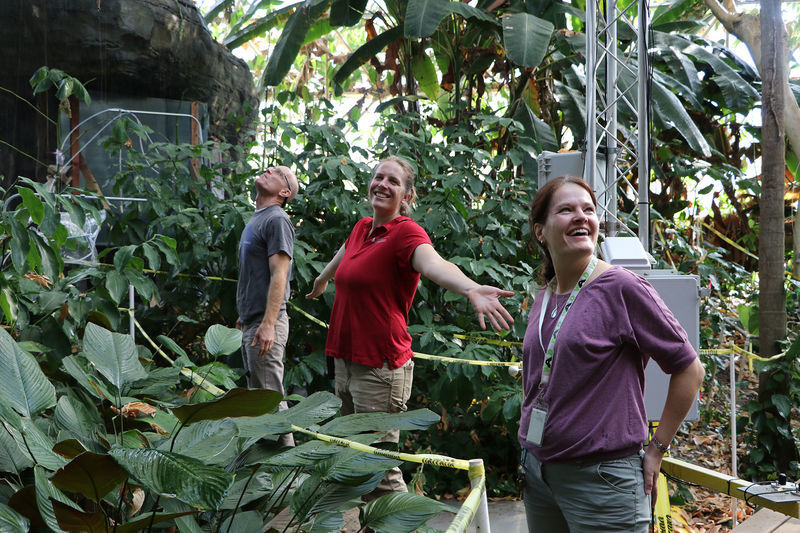After two months of controlled drought, Biosphere 2’s tropical rainforest is dancing in the rain once again.
The University of Arizona’s Biosphere 2, located north of Tucson, is home to several self-sustained ecosystems designed to imitate earth’s environment. One such ecosystem, the rainforest, houses 90 plant species in an area the size of seven tennis courts.
The 30-year-old rainforest is now part of Biosphere 2’s latest experiment, which was designed to shed light on how tropical ecosystems will fare under the stress of a hotter, drier shift in climate. Since October, the rainforest went without water so researchers could study the ecosystem’s response to drought as well as its ability to recover from it.
Last month, researchers turned the water back on and released what would amount to 12,000 gallons of water on the rainforest — marking the first rain in more than two months.
“This is the hottest tropical rainforest in the world, making it an ecosystem laboratory for studying how forests respond to the combined pressures of warming and drought,” said Laura Meredith, rainforest science director for Biosphere 2 and one of three leads on the international project. “We are attempting to monitor from top to bottom – from soils to canopy – the resiliency and vulnerability of plants, microbes and their interactions to environmental stress.”
The project, called Water, Atmosphere and Life Dynamics, brings together 80 scientists and equipment from 13 institutions across the globe. The experiment is fueled in part by a $2.1 million European Research Council grant secured by Christiane Werner, a professor of ecosystem physiology at Germany’s University of Freiburg.
Often called the “lungs of the planet,” rainforests play a significant role in earth’s carbon cycle and help to regulate levels of greenhouse gases in the atmosphere. With changing climate and environmental stability, researchers say their fate is more important than ever.
“We do know that global climate change is progressing. We don’t understand how ecosystems are going to behave,” said Joaquin Ruiz, vice president of global environmental futures at the UA.
Prior to shutting off the rain, researchers laid nearly 2 miles of Teflon tubing and more than 133 sensors throughout the rainforest to help them collect measurements and monitor things such as vegetation, carbon pools and soil.
“We want to know how drought changes the speed of carbon cycling in forest ecosystems. Additionally, we want to understand how plants and microbes choose to ‘spend’ their carbon in drought versus non-drought periods,” Meredith said. “The plants in the Biosphere 2 rainforest are all individuals living in different terrain, light and moisture conditions, so we ask these questions from the standpoint of understanding how individual plants contribute to the response of an entire ecosystem to drought, capturing this complexity in controlled ecosystem science.”
Now that rain has returned, researchers will study how the forest readjusts and track system changes throughout its recovery. Then, the scientists will have to analyze the massive amount of data that’s been collected since the experiment began.
“There’s no other place in the world where you can encapsulate a rainforest, subject it to a drought and then bring it out of that drought on a schedule that you dictate,” said John Adams, deputy director of Biosphere 2. “This gives scientists a really unique opportunity to have everything well poised so they can monitor and collect data that oftentimes is very difficult or impossible to get in the field.”
Biosphere 2 officials are hoping to open the rainforest to the public again by the end of January, but they say it will depend on how the forest responds to the experiment.





